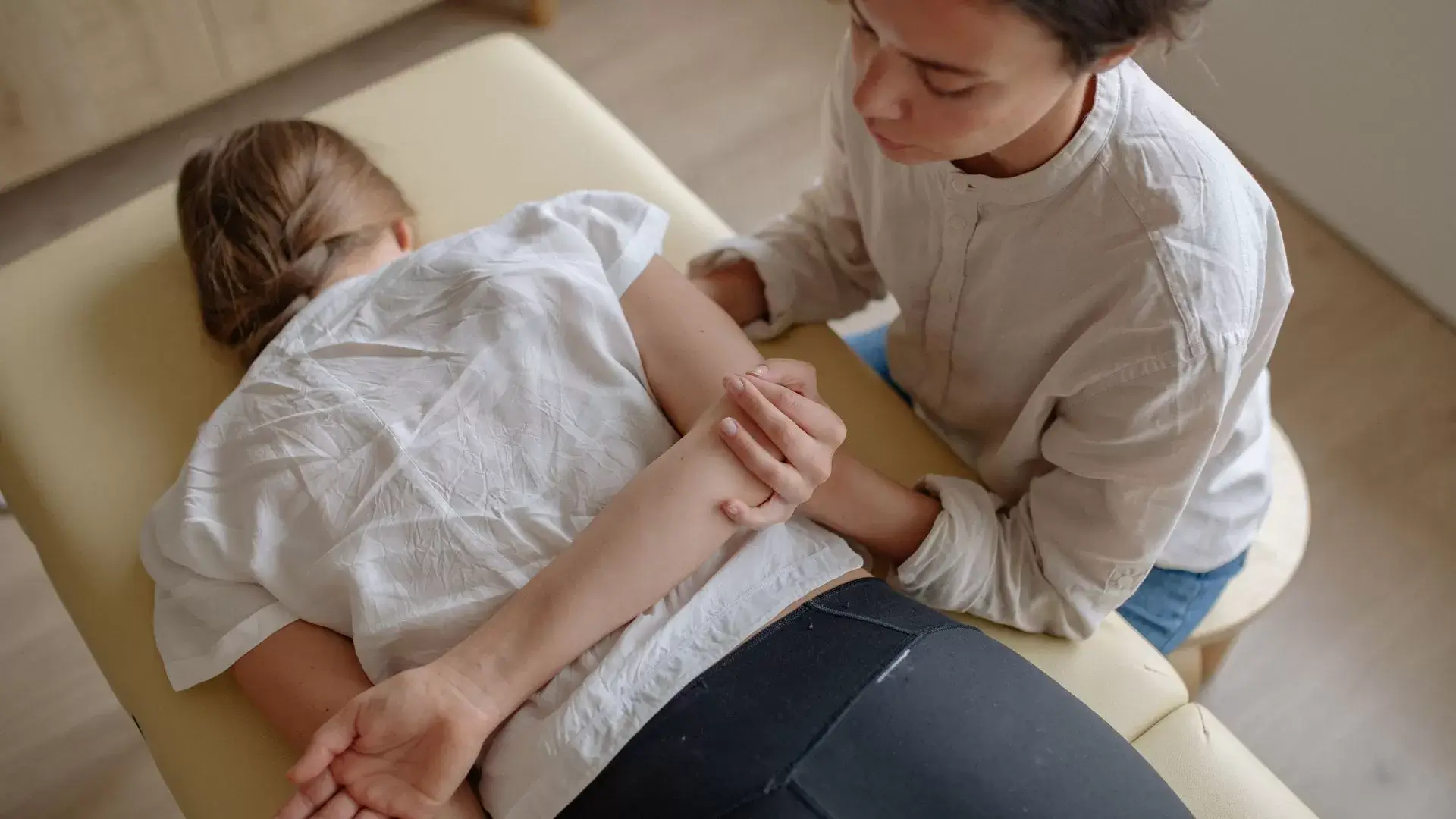If you’re seeking a chiropractor for kyphosis in Mississauga, we’re here to help. We focus on thorough assessments to understand your specific condition. Our skilled team provides personalized treatment plans, including spinal adjustments and therapeutic exercises, aimed at improving your posture and alleviating pain. We also emphasize postural education and ergonomic adjustments to support your daily activities. Through our holistic approach, we aim to enhance your overall well-being and quality of life. To discover how we can assist you further, we encourage you to explore the various options we offer for effective kyphosis management.

At Mississauga Physio Chiro Clinic, we consistently provide extensive physiotherapy and chiropractic services tailored to address the unique needs of individuals with kyphosis. We recognize that kyphosis can lead to discomfort and mobility challenges, which is why our approach focuses on postural correction and holistic spine care.
Our Best Physiotherapy and Chiropractic Services in Mississauga include chiropractic adjustments and spinal manipulation to help realign the spine, relieving pain and improving function. We emphasize pain management strategies that empower our patients to take control of their health. Through targeted rehabilitation exercises and mobility exercises, we aim to strengthen the muscles supporting the spine, enhancing overall stability.
We also prioritize postural awareness, teaching our patients how to maintain proper posture in daily activities to prevent further complications. Our team is dedicated to creating personalized treatment plans that not only address current symptoms but also promote long-term wellness. By focusing on the interconnectedness of the body, we endeavor to provide an all-encompassing approach to managing kyphosis. Together, we can work towards improving your quality of life and supporting your journey to better spinal health.
Kyphosis, often characterized by an exaggerated forward curvature of the spine, can arise from various causes and presents in different forms, each requiring specific attention and management strategies. One common type is hyperkyphosis, where the spinal curvature is excessive, leading to a rounded back appearance. This condition can often be exacerbated by postural kyphosis, which results from poor posture habits over time.
Congenital kyphosis is another form, originating from spinal deformities present at birth, while degenerative disc disease can contribute to kyphosis as the spine ages and discs deteriorate. All these forms of kyphosis can lead to vertebral compression and contribute to significant back pain, impacting daily activities and overall quality of life.
Understanding the different types of kyphosis is essential for effective management. We need to recognize that each type may require tailored treatment approaches, including chiropractic care, physical therapy, or, in severe cases, surgical intervention. By identifying the underlying causes and types of kyphosis, we can adopt proactive measures to alleviate discomfort and improve spinal health, fostering better posture and mobility for ourselves and others.
Recognizing the signs and symptoms of kyphosis is important for addressing this condition effectively and can help us understand when to seek professional assistance. Kyphosis often manifests as a noticeable hunched posture, which may stem from poor posture over time or conditions like Scheuermann’s kyphosis.
We might experience upper back pain or thoracic pain, especially after long periods of sitting or standing. Stiffness in the spine can also be a common symptom, accompanied by muscle tightness in the surrounding areas. These sensations can lead to a postural imbalance, making it even more challenging to maintain proper alignment.
It’s essential to pay attention to these signs, as spinal misalignment can worsen if left untreated. If we notice a combination of these symptoms, it could indicate that kyphosis is developing or worsening, and seeking professional help would be a wise decision. Early intervention can make a significant difference in managing the condition, improving our overall quality of life. By being proactive about recognizing these signs, we can take important steps towards better spinal health and well-being.
Chiropractic care plays an essential role in managing kyphosis by addressing spinal alignment issues and promoting better posture through tailored treatment plans. As chiropractors, we focus on extensive kyphosis treatment strategies that begin with a thorough spinal assessment. This allows us to identify any misalignments and develop a customized approach to care.
Manual therapy is a core component of our treatment, as it helps in spinal correction and alleviating discomfort. We often incorporate postural therapy to educate patients about maintaining proper posture throughout their daily activities. In addition, we recommend flexibility exercises and strengthening exercises to enhance muscle support around the spine, which is vital for long-term improvement.
In addition to hands-on treatment, we emphasize the importance of ergonomic adjustments in the workplace and home environments to minimize strain on the back. By integrating physiotherapy techniques, we can additionally facilitate recovery and promote mobility. Overall, our goal is to empower our patients with the knowledge and tools they need to manage their kyphosis effectively and improve their quality of life. Together, we can work towards achieving a healthier, more aligned spine.

Identifying spinal misalignments and postural imbalances is essential for developing an effective treatment plan tailored to each patient’s unique needs. During a chiropractic assessment, we evaluate the spine and posture to determine the presence of conditions like kyphosis, which can manifest as thoracic kyphosis or cervical kyphosis. By examining the curvature of the spine, we can identify areas of spinal instability that may contribute to discomfort or pain.
Our assessment also considers how postural imbalances affect body mechanics, particularly in relation to daily activities and workplace ergonomics. Poor posture can lead to further complications, including muscle strain and increased risk of injury. Through a thorough evaluation, we can pinpoint specific areas that require attention.
Once we identify these misalignments, we can devise a personalized treatment plan that may include chiropractic adjustments, physical therapy, and recommendations for improving body mechanics and ergonomics at work. By focusing on these elements, we aim to support our patients in achieving better posture and overall spinal health, ultimately enhancing their quality of life.
How can targeted adjustments effectively address postural kyphosis and promote a healthier spinal alignment? Through chiropractic adjustments, we can specifically target spinal rigidity and the misalignments that contribute to postural kyphosis. These adjustments help restore proper alignment, reducing the strain on muscles and ligaments, thereby alleviating discomfort associated with forward head posture and musculoskeletal dysfunction.
Additionally, techniques like spinal traction and myofascial release can further enhance our treatment approach. Spinal traction helps to decompress the spine, allowing for improved mobility and posture. Myofascial release focuses on relieving tension in the soft tissues, which can be essential for those experiencing tightness due to poor posture.
Incorporating core strengthening exercises and stretching routines into our daily activities can complement chiropractic care. Strengthening the core supports the spine, while stretching routines improve flexibility, helping to counteract the effects of postural kyphosis. For those requiring extra support, posture braces can aid in maintaining proper alignment throughout the day.
With a thorough approach that includes chiropractic adjustments, we can greatly improve postural kyphosis and encourage a healthier, more balanced spine.
Scheuermann’s kyphosis presents unique challenges, but with targeted chiropractic approaches, we can effectively manage its symptoms and promote better spinal health. This condition often involves vertebral wedging, which can lead to discomfort and potential complications like compression fractures and disc degeneration.
To address these issues, we utilize a combination of techniques. To begin with, spinal orthotics can help support the spine, improving posture and reducing strain. Additionally, we incorporate movement therapy, including yoga for posture and Pilates for posture, to enhance flexibility and strength in the core and back muscles.
Massage therapy is another essential component, as it aids in relieving tension and improving circulation to the affected areas. We focus on creating individualized treatment plans that consider the unique needs of each patient, ensuring that we address their specific symptoms and challenges.
Managing conditions like Dowager’s hump and osteoporotic kyphosis requires a multifaceted chiropractic approach that focuses on enhancing spinal alignment and overall health. At our clinic located at 1834 Lakeshore Rd W #6C, Mississauga, ON L5J 1J7, we recognize how these conditions can lead to discomfort, including neck pain and shoulder pain.
We prioritize individualized treatment plans that may incorporate trigger point therapy to alleviate muscle tension and improve flexibility. Additionally, we emphasize the importance of proper workstation setup to prevent worsening symptoms. This holistic approach helps in managing pain effectively while promoting better posture.
While anti-inflammatory medication can provide temporary relief, we aim to address the underlying issues through chiropractic adjustments and rehabilitative exercises. For some patients with severe kyphosis, we might discuss the possibility of spinal fusion surgery as a last resort, although our focus remains on non-invasive treatment options.

In addressing the discomfort associated with kyphosis, we utilize a variety of chiropractic techniques aimed at relieving pain and reducing stiffness for our patients. For those experiencing Scheuermann’s kyphosis or dowager’s hump, our approach focuses on gentle spinal adjustments and targeted therapies to alleviate tension and improve mobility.
One effective method we employ is the Alexander Technique, which emphasizes body awareness and movement efficiency. This technique can help patients with hunchback postures to align their spine more effectively, reducing stiffness and enhancing overall comfort.
We also incorporate specific exercises designed to strengthen the back and core muscles, which are essential for supporting the spine and preventing further complications, such as lumbar kyphosis or osteoporotic fractures. By using these chiropractic techniques, we aim to provide thorough pain relief and enhance our patients’ quality of life.
Ultimately, our goal is to empower each individual with tools and strategies that foster long-term wellness, enabling them to manage their kyphosis with confidence. Through our dedicated approach, we’re committed to helping our patients achieve a pain-free and more flexible lifestyle.
Correcting postural imbalances is essential for maintaining long-term spinal health and preventing further complications associated with kyphosis. Many of us may not realize that conditions like Scheuermann’s kyphosis can develop from poor posture, leading to a dowager’s hump or even text neck due to excessive slouching. We must prioritize our posture and make conscious efforts to improve it to avoid these complications.
In our journey toward better spinal health, we can explore various methods to correct these imbalances. The Feldenkrais Method, for example, emphasizes body awareness and movement re-education, helping us develop more efficient posture. For those considering more immediate intervention, options like kyphoplasty and vertebroplasty may be discussed with our healthcare providers, especially when surgery for kyphosis becomes a consideration.
To address the discomfort and structural issues associated with kyphosis, we can consider spinal decompression and traction therapy as effective treatment options. These therapies work by gently stretching the spine, which helps to alleviate pressure on the vertebrae and discs. By doing so, they aim to improve spinal alignment and reduce pain.
Spinal decompression therapy involves using a specialized table that creates a vacuum effect between the vertebrae. This process can help to reduce nerve root compression, promote better blood flow, and facilitate healing. It’s particularly beneficial for those experiencing pain or discomfort due to kyphosis.
Traction therapy, on the other hand, uses mechanical devices to apply a pulling force to the spine. This technique can help to elongate the spine and relieve tension in the surrounding muscles and ligaments. Both therapies are non-invasive and can be tailored to meet individual needs, making them suitable options for many patients.
As we explore these treatment modalities, it is crucial to work closely with our chiropractor to determine the most appropriate course of action for our specific condition. Together, we can find the relief and support we need for better spinal health.
Incorporating specific strengthening and stretching exercises can greatly enhance our postural support and help alleviate the effects of kyphosis. By focusing on our core, back, and shoulder muscles, we can promote better alignment and stability, which is crucial for maintaining an upright posture.
One effective strengthening exercise is the plank, which engages our core muscles and helps support the spine. We can also perform rows with resistance bands to strengthen the upper back, countering the forward pull of kyphosis. Additionally, incorporating exercises like wall angels can help improve shoulder mobility and strengthen the muscles that keep our shoulders in proper alignment.
Stretching is equally important. We should focus on the chest and shoulder areas, as tightness here can exacerbate postural issues. Simple stretches, such as doorway stretches and upper back stretches, can relieve tension and promote flexibility.
Regularly practicing these exercises can lead to noticeable improvements in our posture and overall well-being. It’s crucial to stay consistent and, if necessary, consult with a chiropractor to tailor a program specific to our needs. Together, we can take meaningful steps toward achieving better postural health.
Making ergonomic adjustments in our workspace can considerably enhance our posture and reduce the strain associated with kyphosis. By optimizing the way we sit, stand, and interact with our environment, we can alleviate discomfort and promote better spinal alignment.
First, let’s ascertain our chairs provide adequate lumbar support. A chair that encourages the natural curve of our spine can make a significant difference. Adjusting the height so our feet rest flat on the floor and our knees are at a right angle helps maintain proper posture.
Next, we should position our computer monitors at eye level, preventing us from leaning forward or straining our necks. Utilizing a stand or an adjustable desk can facilitate this.
Additionally, incorporating regular breaks into our work routine is essential. Standing up, stretching, or walking around can reduce stiffness and keep our muscles engaged.
Lastly, we can benefit from using ergonomic accessories, like keyboards and mouse devices designed to minimize wrist strain. By making these adjustments, we’re not only addressing kyphosis but also enhancing our overall well-being and productivity in our daily activities.
Complementary therapies can play an essential role in our holistic approach to treating kyphosis, addressing not only the physical aspects but also enhancing our overall well-being. By integrating these therapies with chiropractic care, we can create a thorough treatment plan that promotes healing and supports our body’s natural alignment.
One effective complementary therapy is yoga, which helps improve flexibility and strengthen the muscles surrounding the spine. Through specific poses and breathing techniques, we can foster better posture and reduce tension in our back. Additionally, Pilates focuses on core strength, which is vital in maintaining spinal stability.
Massage therapy is another beneficial option, as it alleviates muscle tightness and promotes relaxation. Regular sessions can enhance circulation and decrease discomfort associated with kyphosis. Acupuncture is also worth considering, as it may help relieve pain and improve overall energy flow in our bodies.
Incorporating nutritional counseling into our treatment can further support our journey. A balanced diet rich in anti-inflammatory foods can aid in reducing pain and promoting recovery. By embracing these complementary therapies, we can take proactive steps toward managing kyphosis and enhancing our quality of life.
As we explore the long-term benefits of chiropractic rehabilitation, it’s important to recognize how maintaining proper posture can greatly enhance our overall spinal health and quality of life. Poor posture, especially associated with conditions like kyphosis, can lead to chronic pain, reduced mobility, and even emotional distress. By committing to long-term chiropractic care, we can effectively address these issues.
Chiropractic rehabilitation focuses on aligning our spine and improving musculoskeletal function. Regular adjustments help to correct postural imbalances, which can prevent further complications. Additionally, our chiropractor may recommend exercises and stretches tailored to strengthen our core and back muscles, reinforcing the structural integrity of our spine.
Incorporating lifestyle changes, such as ergonomic adjustments at work and being mindful of our posture throughout the day, also plays an essential role. By actively participating in this holistic approach, we can foster a supportive environment for our spine.
Ultimately, long-term chiropractic rehabilitation not only aids in treating kyphosis but also equips us with the tools to sustain postural health. By prioritizing our spinal wellness, we’re investing in a healthier future, enhancing our daily lives and overall well-being.
If we’re experiencing the effects of kyphosis, scheduling a chiropractic consultation in Mississauga can be an essential step towards finding relief and improving our spinal health. By working with a qualified chiropractor, we can receive a personalized assessment that evaluates our specific condition and needs. This initial consultation often involves a thorough examination of our posture, spinal alignment, and range of motion.
During our appointment, the chiropractor will discuss our symptoms, medical history, and any factors contributing to our kyphosis. Together, we can establish a tailored treatment plan that may include spinal adjustments, exercises, and lifestyle recommendations aimed at strengthening our back muscles.
It’s important to remember that early intervention can lead to better outcomes, so we shouldn’t hesitate to reach out for help. Chiropractic care focuses on holistic wellness, treating not just the symptoms but the underlying issues contributing to our condition. Contact us today!
Mississauga, a vibrant city located in the heart of Ontario, offers a rich blend of cultural diversity, parks, and community services that enhance the quality of life for its residents. As we explore our city, we notice its well-planned neighborhoods and a thriving economy, making it an attractive place for families and professionals alike.
With over 60 parks and numerous recreational facilities, we’ve got ample opportunities for outdoor activities and community engagement. The city’s commitment to health and well-being is evident in its array of wellness services, including chiropractic care, which plays a significant role in addressing various health concerns, such as kyphosis.
Moreover, Mississauga’s diverse population reflects a tapestry of cultures, contributing to a vibrant arts scene and a variety of culinary experiences. We take pride in our community events and festivals that promote inclusivity and foster connections among residents.
In Mississauga, we not only have access to exceptional healthcare services but also a supportive community that encourages us to lead active and healthy lifestyles. This rich environment enhances our overall well-being, making it a wonderful place to live, work, and thrive.

When considering chiropractic treatment for conditions like kyphosis, we typically find that each session lasts around 30 to 60 minutes. The frequency and duration of our treatment plan can vary based on individual needs and progress. Generally, we might expect a series of sessions over several weeks or months to achieve ideal results. It’s important for us to communicate with our chiropractor to guarantee we’re on the right path for our specific situation.
When it comes to insurance coverage for chiropractic care, it really depends on our specific insurance plan. Many plans do cover chiropractic treatments, but the extent of that coverage can vary. We should check with our insurance provider to verify what’s included and any limitations that might apply. It’s essential to understand our benefits before starting treatment, ensuring we’re making informed decisions regarding our care and finances.
Yes, children can receive chiropractic care for kyphosis. In fact, many practitioners believe early intervention can help manage and correct postural issues effectively. It’s important to consult a qualified chiropractor who specializes in pediatric care to guarantee the treatment is safe and appropriate for their age and development. By working together, we can promote better spinal health and support our children’s physical well-being as they grow.
When we’re looking for a chiropractor for kyphosis, we should prioritize their credentials and experience. We need to check if they’re licensed and have specialized training in treating spinal conditions. It’s also helpful to see if they’ve worked with patients who have kyphosis specifically. Additionally, reading reviews and getting referrals can give us insights into their approach and effectiveness. Ultimately, we want someone who understands our needs and can offer personalized care.
When considering chiropractic adjustments for kyphosis, we should be aware that some individuals may experience mild side effects. These can include temporary soreness, stiffness, or increased discomfort following an adjustment. However, these effects are usually short-lived and resolve quickly. It’s essential for us to communicate openly with our chiropractor about any concerns and to follow their recommendations for post-adjustment care to guarantee a positive experience and better overall results.
Reach out to us today to book an appointment or learn more about our services. Our friendly team is here to answer your questions and help you take the first step toward improved health and wellness.
(647) 372-1209

At our Mississauga Physio Chiro Clinic, we are dedicated to providing personalized care that addresses the root cause of your discomfort. With a team of experienced physiotherapists and chiropractors, we focus on restoring your mobility, relieving pain, and enhancing your overall well-being.